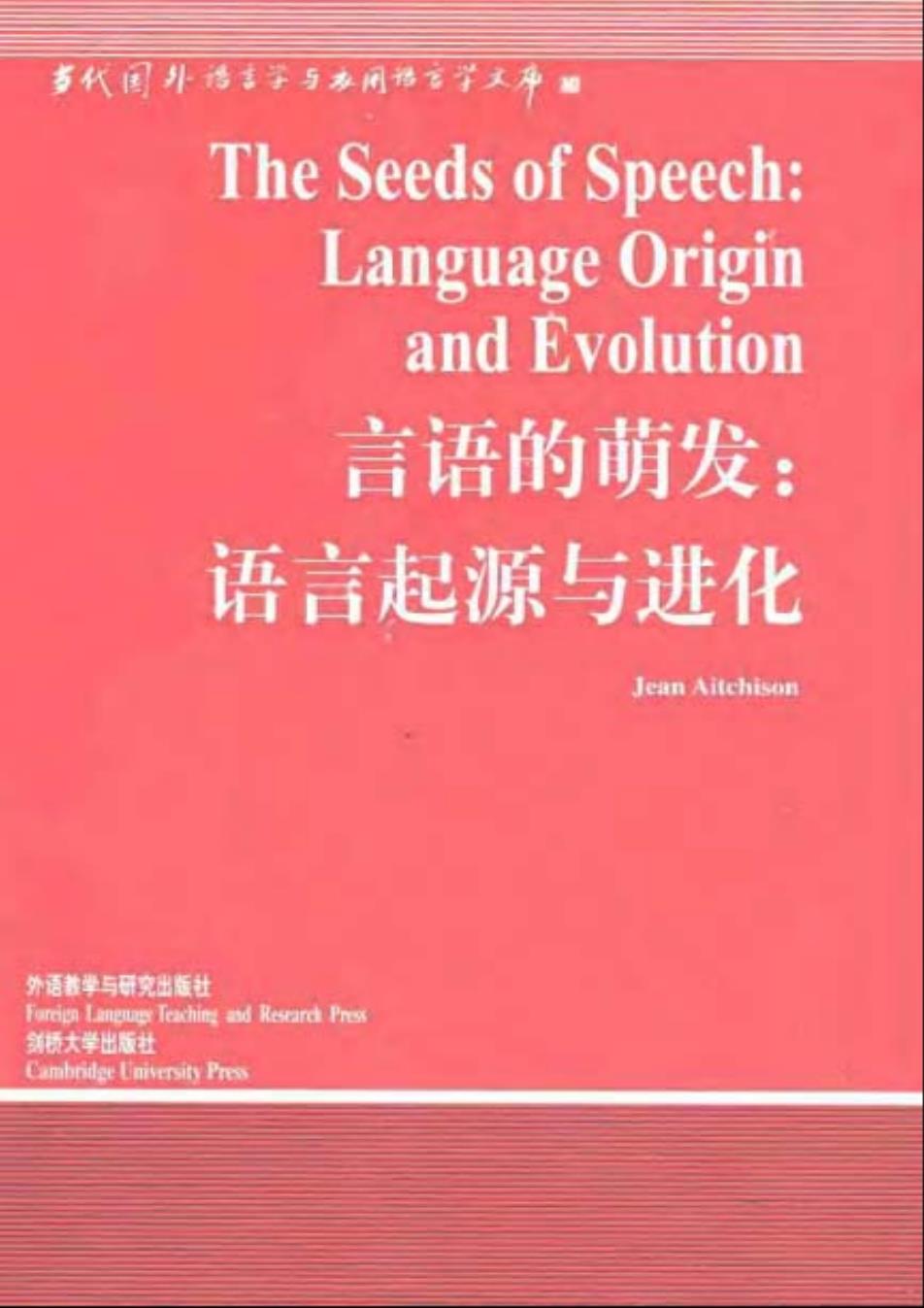
当代国外浩吉学与水网墙云学天平赠 The Seeds of Speech: Language Origin and Evolution 言语的萌发: 语言起源与进化 Jean Aitchison 外语盖拳与可究出能世 Forcign Lanen Teachin asd Resrardh Press 刻领大学出版世 Cambridge Umiversity Press
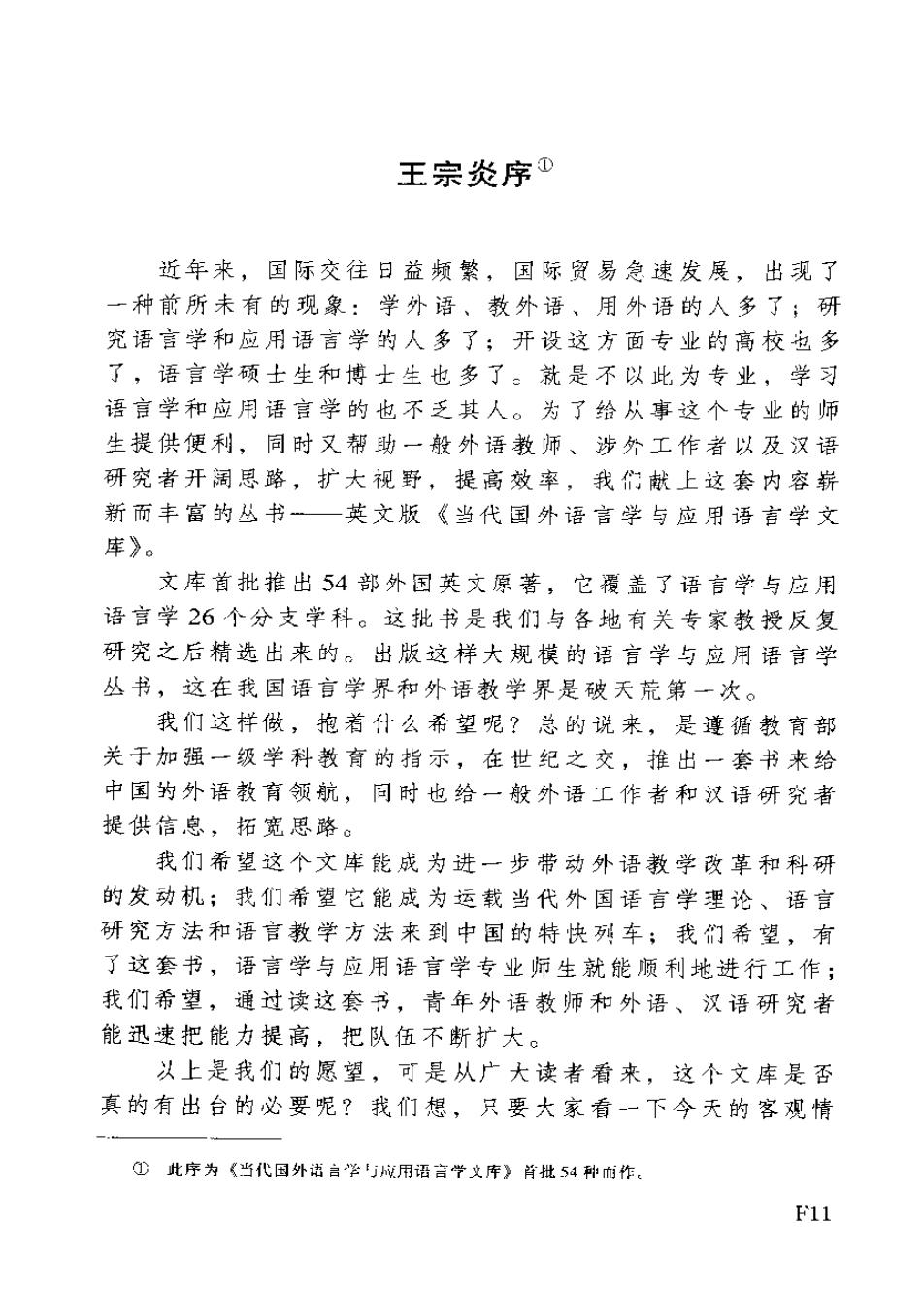
王宗炎序① 近年来,国际交往日益频繁,国际贸易急速发展,出现了 一种前所未有的现象:学外语、教外语、用外语的人多了:研 究语言学和应用语言学的人多了;开设这方面专业的高校也多 了,语言学硕士生和博士生也多了。就是不以此为专业,学习 语言学和应用语言学的也不乏其人。为了给从事这个专业的师 生提供便利,同时又帮助一般外语教师、涉外工作者以及汉语 研究者开阔思路,扩大视野,提高效率,我们献上这套内容崭 新而丰富的丛书一英文版《当代国外语言学与应用语言学文 库》。 文库首批推出54部外国英文原著,它覆盖了语言学与应用 语言学26个分支学科。这批书是我们与各地有关专家教授反复 研究之后精选出来的。出版这样大规模的语言学与应用语言学 丛书,这在我国语言学界和外语教学界是破天荒第一次。 我们这样做,抱着什么希望呢?总的说来,是遵循教育部 关于加强一级学科教育的指示,在世纪之交,推出一套书来给 中国的外语教育领航,同时也给一般外语工作者和汉语研究者 提供信息,拓宽思路。 我们希望这个文库能成为进一步带动外语教学改革和科研 的发动机;我们希望它能成为运载当代外国语言学理论、语言 研究方法和语言教学方法来到中国的特快列车;我们希望,有 了这套书,语言学与应用语言学专业师生就能顺利地进行工作; 我们希望,通过读这套书,青年外语教师和外语、汉语研究者 能迅速把能力提高,把队伍不断扩大。 义上是我们的愿望,可是从广大读者看来,这个文库是否 真的有出台的必要呢?我们想,只要大家看-一下今天的客观情 ①此序为《当代国外话言学城用语言学文库》肖批54种作: F11

况,就知道这套书有填空补缺的作用,是让大家更上一层楼的 扶梯。 我们跟许多人一样,认为国内的外语教学和语言学与应用 语言学研究是成绩斐然的,但是某些不足之处也无庸讳言。 在语言研究方面,有大量工作还等着大家去做。汉语语法 研究,过去由于结构主义的启示,已经成绩卓著,可是现在虽 则引进了功能主义,还看不出什么出色的成果。语料语言学是 新兴学科,在我国刚刚起步,机器翻译从50年代就有人搞,然 而其进展至今不能令人满意。 在语言理论方面,我们不时听到一些片面的、所见不全的 论调。有人说,1957年前西方根本没有什么理论语言学,其创 始者是Chomsky;也有人说,语言纯属社会文化范畴;还有人 说,搞语言研究只有量化方法才是科学方法,定性方法不值得 一提。 谈到外语教学,某些看法做法是分明不值得赞许的。有人 以为交际教学只管听说,不管读写,也有人以为教精读课就是 教阅读,不管口语。在分析课文时老师满堂灌,学生开口不得, 是常见的;教听力课时老师只管放录音,对学生不给半点提示 点拨,也并非罕有现象。 上述这些缺点,我们早有所知,现在我们更加明白,必须 力图改进,再也不能安于现状了。为了改进,我们就得参考国 外的先进理论,借鉴国外的有效措施。眼前这个文库,就是我 们上下求索的结果。 在编辑这个文库时,我们在两方面下了功夫。 一方面,在选书时,我门求全,求新,求有代表性和前瞻性。 我们不偏爱一家之言,也不只收一家外国出版社之书。语言学与 应用语言学的主干学科固然受到了应有的重视,分支学科可也不 忽视。语料语言学、语言统计学是新兴学科,我们收入了专著;句 法学、语义学久已有人研究,我们也找到了有关的最新著作。 另一方面,我们邀请了国内知名的博士生导师、硕士生导 师为各书撰文导读,为读者铺平道路。语言学和应用语言学专 F12
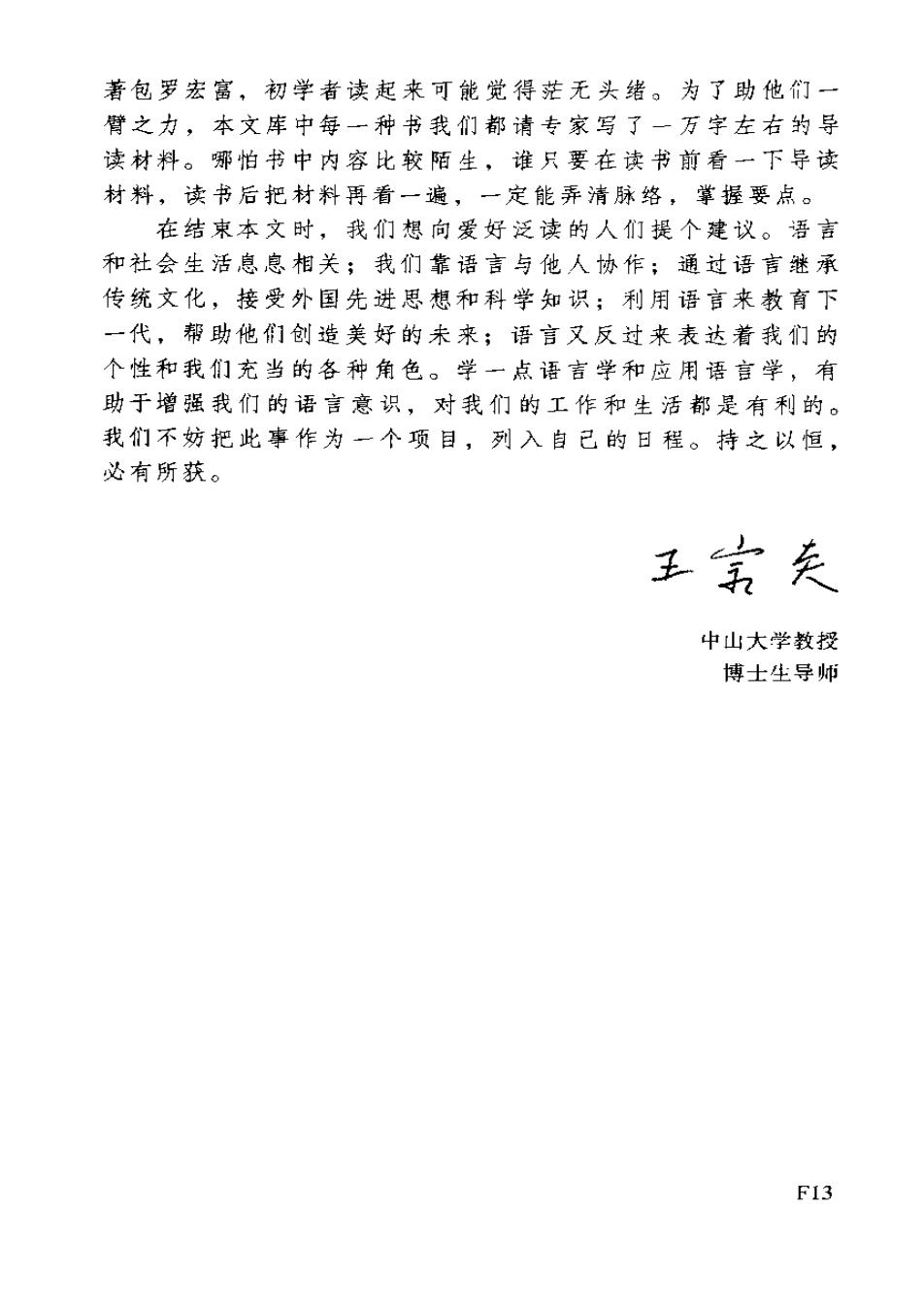
著包罗宏富,初学者读起来可能觉得茫无头绪。为了助他们一 臂之力,本文库中每一种书我们都请专家写了一万字左右的导 读材料。哪怕书中内容比较陌生,谁只要在读书前看一下导读 材料,读书后把材料再看一遍,一定能弄清脉络,掌握要点。 在结束本文时,我们想向爱好泛读的人们提个建议。语言 和社会生活息息相关;我们靠语言与他人协作;通过语言继承 传统文化,接受外国先进思想和科学知识;利用语言来教育下 一代,帮助他们创造美好的未来;语言又反过来表达着我们的 个性和我们充当的各种角色。学一点语言学和应用语言学,有 助于增强我们的语言意识,对我们的工作和生活都是有利的。 我们不妨把此事作为一个项目,列入自已的日程。持之以恒, 必有所获。 王宝关 中山大学教授 博士生导师 F13

Preface by Chomsky It is about half a century since the study of language undertook a rather new ccurse,while renewing some traditional concerns that had long been neglected.The central change was a shift of attention from behavior and the products of behavior (texis,corpora,etc.to the internal mcchanisms that enter into behavior.This was part of a general shilt of perspective in psychology towards what became known as "cognitive science,and was in fact a significant factor in contributing to this development. With this departure from prevailing structuralist and bchavionst approaches,the objcct of inquiry becomes a property of individual persons, my granddaughters for example.We ask what special properties they have that underlie an obvious but noncthelcss remarkable fact.Exposed to a world of "buzzing,booming confusion"(in William James's classic phrasc),each instantly identified some intricate subpart of it as linguistic,and reflexively, without awarencss or instruction which would be useless in any event), performed analytic operations that led to knowledge of some specific linguistic system.in one case,a variety of wha:is called informally "English,"in another a variety of "Spanish.It could just as casily been one of the Chinese languages,or an aboriginal language of Australia,or some other human language.Exposed to the same environment,their pet cats (or chimpanzees, ete.would not even take the first step of identifying the relevant category of phenomena,just as humans do not identify what a bee perceives as the waggle dance that communicatcs the distance and orientation of a source of honey. All organisms have special subsystems that lead them to deal with their environment in specific ways.Some of these subsystems are called "mental" or "cognitive,"informal designations that need not be made precise,just as there is no need to determine exactly where chemistry ends and biology begins.The development of cognitive systems,like others.is influenced by the environment,but the general course is genctically determined.Changes of nutrition,for example,can have a dramatic offect on development,but will not change a human embryo to a bee or a mouse,and the same holds for cognitive development.The cvidence is strong that among the human cognitive systems is a "faculty of language"(FL),to borrow a traditional term:some subsystem of mostly the brain.The cvidence is also overwhelming that apart from severe pathology,FL is close to uniform for humans:it is a genuine species property.The "initial state"of FL is determined by the common human genctic endowment.Exposed to experience,FL passes through a series of statcs,normally reaching a relatively stable state at about puberty,after which changes are peripheral: growth of vocabulary,primarily. F14

As far as we know,every aspect of language -sound,structure, meanings of words and more complex expressions-is narrowly restricted by the properties of the initial state;these same restrictions underlie and account for the extraordinary richness and flexibility of the systems that emerge.It is a virtual truism that scope and limits are intimately related.The biological endowment that allows an embryo to become a mouse,with only the most meager environmental "information,"prevents it from becoming a fly or a monkey.The same must be true of human higher mental faculties,assuming that humans are part of the biological world,not angels. We can think of the states attained by FL,including the stable states, as "languages":in more technical terminology,we may call them "internalized languages"(I-languages).Having an I-language,a person is equipped to engage in the "creative use of language"that has traditionally been considered a primary indication of possession of mind;by Descartes and his followers,to cite the most famous case.The person can produce new expressions over an unbounded range,expressions that are appropriatc to circumstances and situations but not caused by them,and that evoke thoughts in others that they might have expressed in similar ways.The nature of these abilities remains as obscure and puzzling to us as it was to the Cartesians,but with the shift of perspcctive to "internalist linguistics."a great deal has been lcarned about the cognitive structurcs and operations that enter into these remarkable capacities. Though the observation does not bear directly on the study of human language,it is nevertheless of interest that FL appears to be biologically isolated in critical respects,hence a species property in a stronger sense than just being a common human possession.To mention only the most obvious respect,an I-language is a system of discrete infinity,a generative process that yields an unbounded range of expressions,each with a definite sound and meaning.Systems of discrete infinity are rare in the biological world and unknown in non-human communicalion systems.When we look beyond the most elementary properties of human language,its apparently unique features become even more pronounced.In fundamental respects human language does not fall within the standard typologics of animal communication systems,and there is little reason to speculate that it evolved from them,or even that it should be regarded as having the "primary function"of communication (a rather obscure notion at best )Language can surely be used for communication,as can anything people do,but it is not unreasonable to adopt the traditional view that language is primarily an instrument for expression of thought,to others or to oneself;statistically speaking,use of language is overwhelmingly internal,as can casily be determined by introspection. Viewed in the internalist perspcctive,the study of language is part of biology,taking its place alongside the study of the visual system,the "dance faculty"and navigational capacities of bees,the circulatory and digestive F15
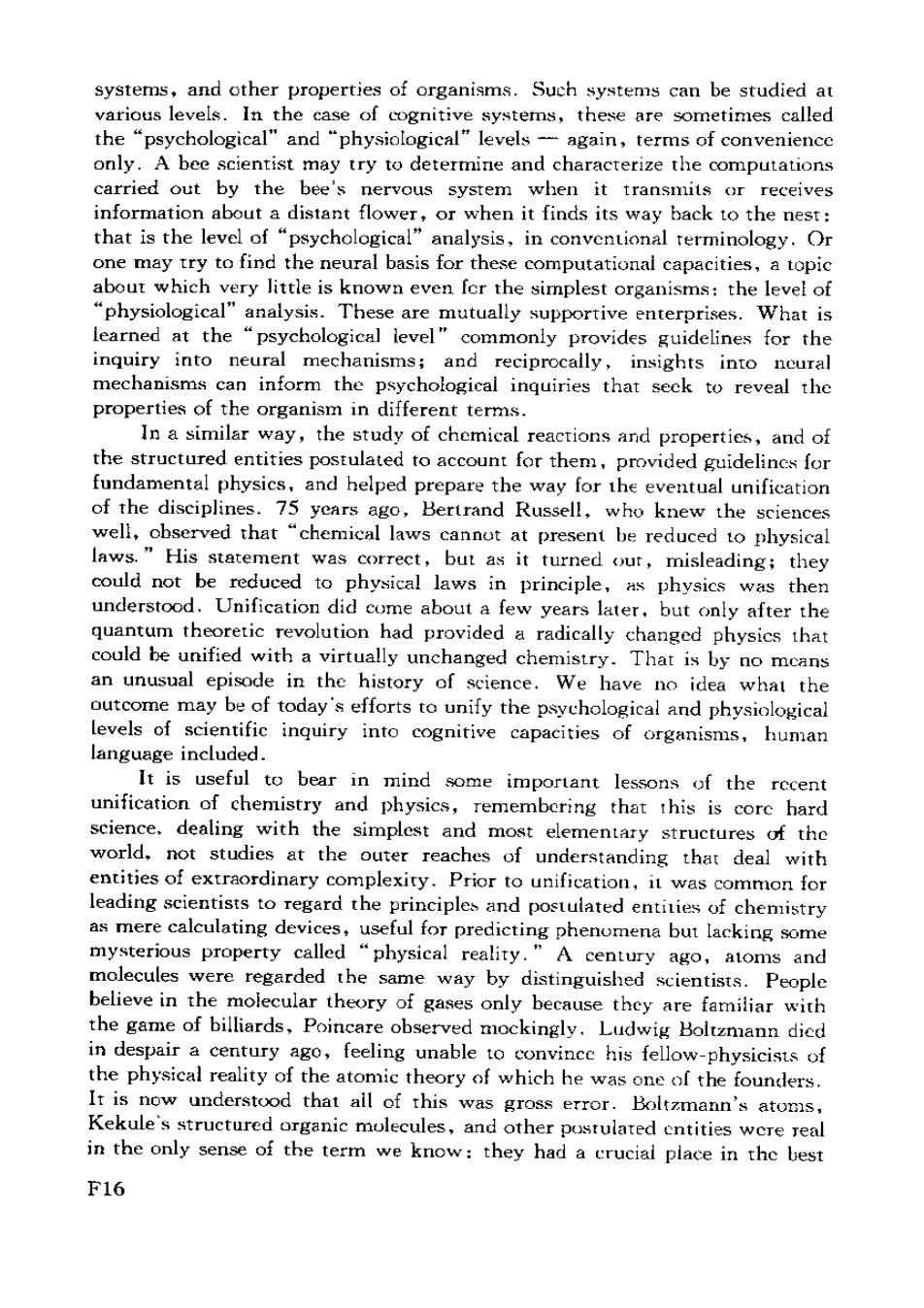
systems,and other properties of organisms.Such systems can be studied at various levels.In the case of cognitive systems,these are sometimes called the "psychological"and "physiological"levels-again,terms of convenience only.A bee scientist may try to determine and characterize the computations carried out by the bee's nervous system when it transmits or receives information about a distant flower,or when it finds its way back to the nest: that is the level of "psychological"analysis,in conventional terminology.Or one may try to find the neural basis for these computational capacities,a topic about which very little is known even fcr the simplest organisms:the level of "physiological"analysis.These are mutually supportive enterprises.What is learned at the "psychological level"commonly provides guidelines for the inquiry into neural mechanisms;and reciprocally,insights into ncural mechanisms can inform the psychological inquiries that seck to reveal the properties of the organism in different terms. In a similar way,the study of chemical reactions and properties,and of the structured entities postulated to account for them,provided guidelines for fundamental physics,and helped prepare the way for the eventual unification of the disciplines.75 years ago,Bertrand Russell,who knew the sciences well,observed that "chemical laws cannot at present be reduced to physical laws.His statement was correct,but as it turned out,misleading;they could not be reduced to physical laws in principle,as physics was then understood.Unification did come about a few years later,but only after the quantum theoretic revolution had provided a radically changed physics that could be unified with a virtually unchanged chemistry.That is by no mcans an unusual episode in the history of science.We have no idea what the outcome may be of today's efforts to unify the psychological and physiological levels of scientific inquiry into cognitive capacities of organisms,human language included. It is useful to bear in mind some important lessons of the recent unification of chemistry and physics,remembering that this is core hard science,dealing with the simplest and most elementary structures of the world,not studies at the outer reaches of understanding that deal with entities of extraordinary complexity.Prior to unification,it was common for leading scientists to regard the principles and postulated entilies of chemistry as mere calculating devices,useful for predicting phenomena but lacking some mysterious property called "physical reality."A century ago,atoms and molecules were regarded the same way by distinguished scientists.People believe in the molecular theory of gases only because they are familiar with the game of billiards,Poincare observed mockingly.Ludwig Boltzmann died in despair a century ago,feeling unable to convince his fellow-physicists of the physical reality of the atomic theory of which he was one of the founders. It is now understood that all of this was gross error.Boltzmann's atoms, Kekule's structured organic molecules,and other postulated cntities were real in the only sense of the term we know:they had a crucial place in the best F16
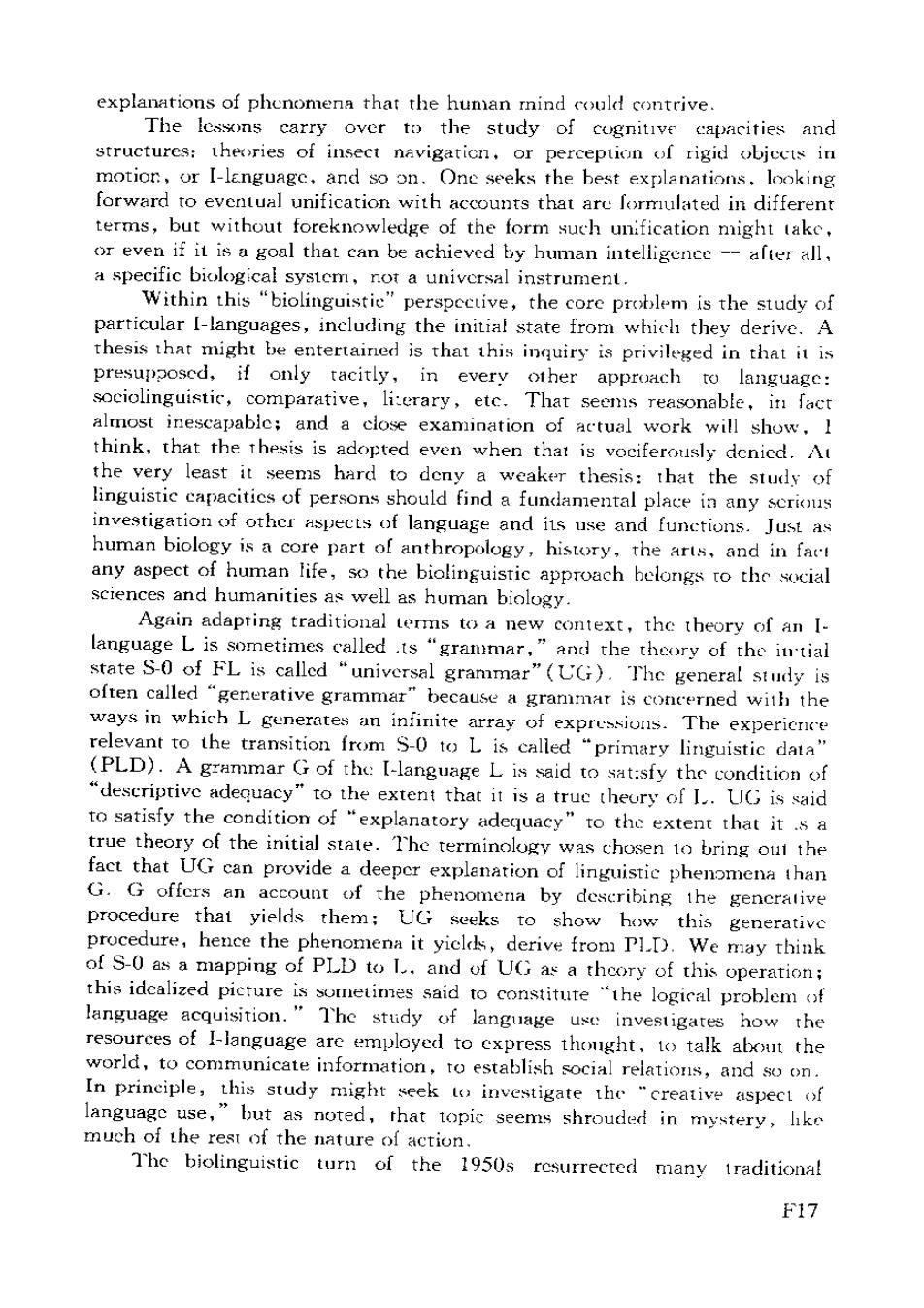
explanations of phenomena that the human mind could contrive. The lessons carry over to the study of cognitive capacities and structures:theories of insect navigaticn,or perception of rigid objects in motior,or I-languagc,and so on.One seeks the best explanations.looking forward to eventual unification with accounts that are formulated in different terms,but without foreknowledge of the form such unification might take, or even if it is a goal that can be achieved by human intelligence--after all, a specific biological sysicm,not a universal instrument. Within this "biolinguistic"perspcctive,the core problem is the study of particular I-languages,including the initial state from which they derive.A thesis that might be entertained is that this inquiry is privileged in that it is presupposed,if only tacitly,in every other approach to language: sociolinguistic,comparative,literary,etc.That seems reasonable,in fact almost inescapablc;and a close examination of actual work will show.I think,that the thesis is adopted even when that is vociferously denied.At the very least it seems hard to deny a weaker thesis:that the study of linguistic capacitics of persons should find a fundamental place in any scrious investigation of other aspects of language and its use and functions.Just as human biology is a core part of anthropology,history,the arts,and in fact any aspect of human life,so the biolinguistic approach belongs to the social sciences and humanities as well as human biology. Again adapting traditional terms to a new context,the theory of an I- language L is sometimes calledts "grammar,"and the theory of the iutial state S-0 of FL is called "universal grammar"(UG).The general study is often called "generative grammar"because a grammar is concerned with the ways in which L generates an infinite array of expressions.The expericnce relevant to the transition from S-0 to L is called "primary linguistic data" (PLD).A grammar G of the:I-language L is said to sat:sfy the condition of "descriptive adequacy"to the extent that it is a true theory of I..UG is said to satisfy the condition of "explanatory adequacy"to the extent that it .s a true theory of the initial state.The terminology was chosen 1o bring out the fact that UG can provide a deeper explanation of linguistic phenomena than G.G offers an account of the phenomena by describing the gencrative procedure that yields them;UG seeks to show how this generative procedure,hence the phenomena it yiclds,derive from PLD).We may think of S-0 as a mapping of PLD to I..and of UG as a theory of this operation; this idealized picture is sometimes said to constitute "the logical problem of language acquisition."The study of language use investigates how the resources of I-language are employed to express thought,to talk about the world,to communicate information,to establish social relations,and so on. In principle,this study might seek to investigate the "creative aspect of language use,but as noted,that topic seems shrouded in mystery,hke much of the rest of the nature of action. The biolinguistic turn of the 1950s resurrected many traditional F17

questions,but was able to approach them in new ways.with the help of intellectual tools that had not previously been available:in particular,a clear understanding of the nature of recursive processes,generative procedures that can characterize an infinity of objects (in this case,expressions of L)with finite means the mechanisms of L).As soon as the inquiry was seriously undertaken,it was discovered that traditional grammars and dictionaries.no matter how rich and detailed,did not address central questions about linguis ic expressions.They basically provide "hints"that can be used by somcone cquipped with FL and some of its states,but leave the nature of these systems unexamined.Very quickly,vast ranges of new phenomena were discovered,along with new problems,and sometimes at least partial answers. It was recognized very soon that there is a serious tension between the scarch for descziptive and for explanatory adequacy.The former appears to lead to very intricate rule systems,varying among languages and among constructions o:a particular language.But this cannot be correct,since each language is attained with a common FL on the basis of PLD providing l.ttle information about these rules and constructions. The dilemma led to efforts to discover general propertics of rule systems that can be extracted from particular grammars and attributed to UG,leaving a residue simple enough to be attainable on the basis of PLD.About 25 years ago,these efforts converged in the so-called "principles and parameters' (P&P)approach,which was a radical break from traditional ways of looking at language.The P&P approach dispenses with the rules and constructions that constituted the framework for traditional grammar,and were taken over,pretty much,in early generative grammar.The relative clauses of Hungarian and verb phrases of Japanese exist,but as taxonomic artifacts, rather like "terrestrial mammal"or "creature that flies.The rules for forming them are decomposed into principles of UG that apply to a wide variety of traditional constructions.A particular language L is determined by fixing the values of a finite number of "parameters"of S-0:Do heads of phrases precede or follow their complements?Can certain categories be null (lacking phonetic realization)?Etc.The parameters must be simple enough for values to be set on the basis of restricicd and easily obtained data. Language acquisition is the process of fixing these values.The parameters can be thought of as "atoms"of language,to borrow Mark Baker's metaphor. Each human language is an arrangement of these atoms,determined by assigning values to the parameters.The fixed principles are available for constructing expressions however the atoms are arranged in a particular I- language.A major goal of research,then,is to discover something like a "periodic table"that will explair.why only a very small fraction of imaginable linguistic systems appear to be instantiated,and attainable in the normal way. Note that the P&P approach is a program,not a specific theory;it .s a F18
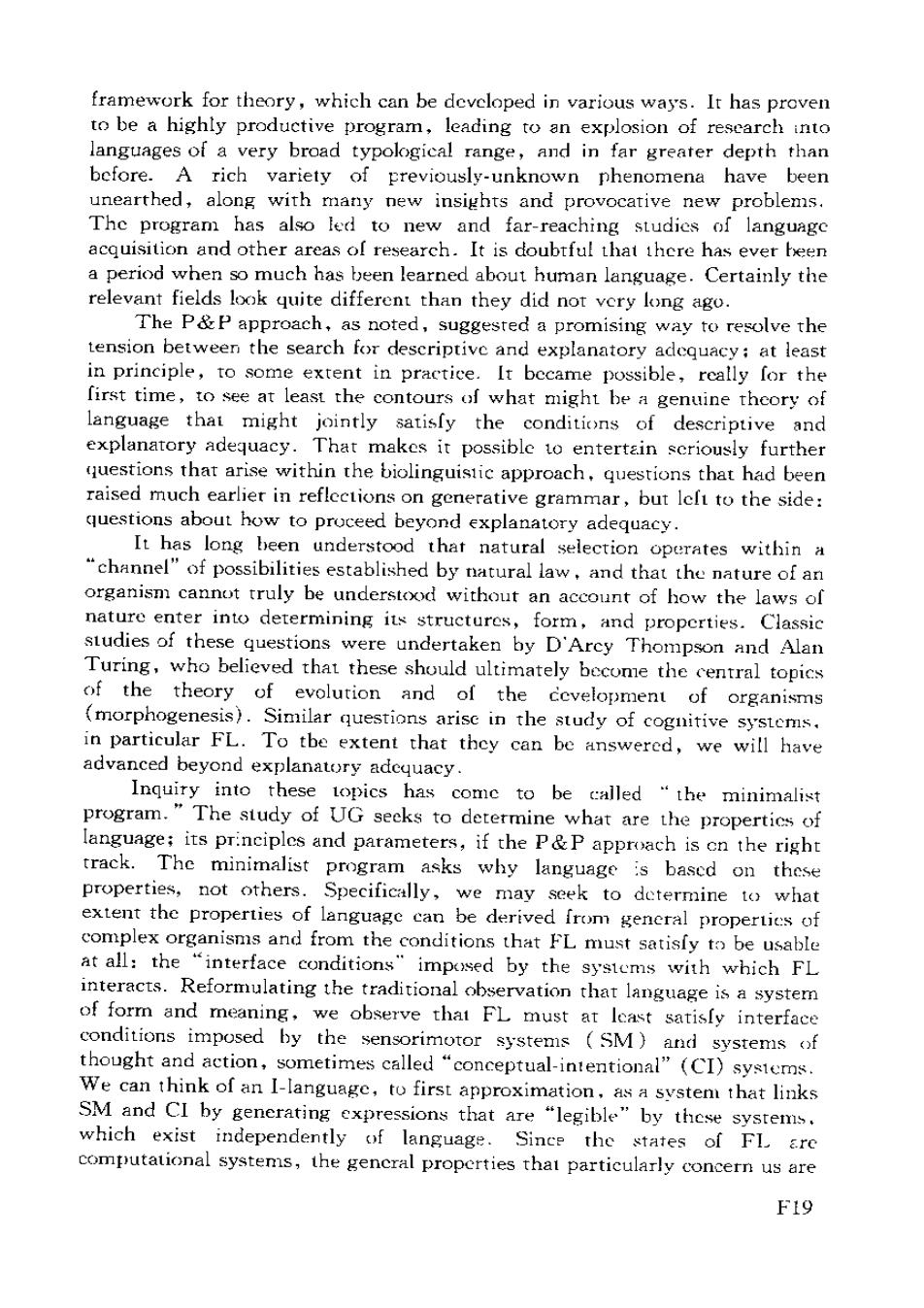
framework for theory,which can be devcloped in various ways.It has proven to be a highly productive program,leading to an explosion of research into languages of a very broad typological range,and in far greater depth than before.A rich variety of previously-unknown phenomena have been unearthed,along with many new insights and provocative new problems. The program has also led to new and far-reaching studies of language acquisition and other areas of research.It is doubtful that there has ever been a period when so much has been learned about human language.Certainly the relevant fields look quite different than they did not very long ago. The P&P approach,as noted,suggested a promising way to resolve the tension between the search for descriptive and explanatory adequacy at least in principle,to some extent in practice.It became possible,really for the first time,to see at least the contours of what might be a genuine theory of language that might jointly satisfy the conditions of descriptive and explanatory adequacy.That makes it possible to entertain scriously further questions that arise within the biolinguistic approach,questions that had been raised much earliet in reflections on generative grammar,but left to the side: questions about how to proceed beyond explanatory adequacy. It has long been understood that natural selection operates within a "channel"of possibilities established by natural law,and that the nature of an organism cannot truly be understood without an account of how the laws of nature enter into determining its structures,form,and properties.Classic studies of these questions were undertaken by D'Arcy Thompson and Alan Turing,who believed that these should ultimately become the central topics of the theory of evolution and of the cevelopment of organisms (morphogenesis).Similar questions arisc in the study of cognitive systems. in particular FL.To tbe extent that they can be answered,we will have advanced beyond explanatory adequacy. Inquiry into these topics has come to be called "the minimalist program.The study of UG seeks to determine what are the propertics of language;its principles and parameters,if the P&P approach is cn the right track.The minimalist program asks why language is based on these properties,not others.Specifically,we may seek to dctermine to what extent the properties of language can be derived from general propertics of complex organisms and from the conditions that FL must satisfy to be usable at all:the "interface conditions"imposed by the systems with which FL interacts.Reformulating the traditional observation that language is a system of form and meaning,we observe that FL must at least satisly interface conditions imposed by the sensorimotor systems (SM)and systems of thought and action,sometimes called "conceptual-intentional"(CI)systems. We can think of an I-language,to first approximation,as a system that links SM and CI by generating expressions that are "legible"by these systems. which exist independently of language.Since the states of FL are computational systems,the gencral properties that particularly concern us are F19